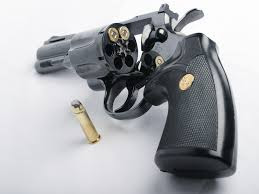POST GUN
Friday, July 14, 2017
Cleaning For Your Family's Health: Carpet Cleaning Services Focused On Allergy Relief, York, Ontario
Cleaning For Your Family's Health: Carpet Cleaning Services Focused On Allergy Relief, York, Ontario
Sunday, December 4, 2016
How does it fire a bullet at that speed?
First of all, there are many types of guns. Different types of guns may have different ways to feed the bullet. Generally a revolver uses revolving cylinder mechanism to feed a new bullet after each shot.
There are different components in a revolver.
If you want to fire a bullet you have to pull the trigger , and the mechanism is designed in a way such that , hammer is pushed back which will compress the spring and at the same time the cylinder which hoses bullets in also rotated.
If you pull the trigger all the way back , the leaver inside the trigger will release the hammer and the whole potential energy stored in the spring is now being used to push the hammer forward.
So now hammer will make an impact at the back side of the bullet, which will activate the chemical reaction in the bullet.
Lets see how this chemical reaction makes a bullet run so fast.
A bullet has different components, each component has a different function to perform.
At the back ,there is primer. Function of the primer is to ignite the spark after the impact of hammer.
Then this small spark generated from the impact of the hammer will activate the reaction in the powder propellant. Propellant is a mixture of two compounds.One is fuel and other is oxidizer. This reaction will form a huge volume of gases at very high speed ,which will force the bullet to go out of the gun at very high speed.
In the front ,there is a metal jacket ,which is responsible of the actual damage done by the bullet.
So that's how a gun fires a bullet at very high speed.
How does a revolver work
How Revolvers Work
In 1830, when he was only 16, Samuel Colt left home and took a job on a merchant ship bound for India. In his spare time, he toyed with designs for a new sort of gun - one that could be fired repeatedly without reloading. While a number of repeating weapons had already been developed, none of them had caught on with the public, mostly because they were too complicated and cumbersome.
Inspired by a capstan mechanism on the ship, Colt developed a simple revolving ammunition cylinder. Initially, people weren't particularly impressed with the new weapon; but by the 1850s, Colt's company was enjoying phenomenal success. In 1856, he had to churn out 150 guns a day just to keep up with the growing demand!
Gun Basics and History
To understand how a revolver works, it helps to know something about guns in general. Almost every gun is based on the same simple concept: You apply explosive pressure behind a projectile to launch it down a barrel. The earliest and simplest application of this idea is the cannon.
A cannon is just a metal tube with a closed end and an open end. The closed end has a small fuse hole. To load the cannon, you pour in gunpowder (a mixture of charcoal, sulfur and potassium nitrate), and then drop in a cannonball. The gunpowder and cannonball sit in the breech, the rear part of the bore (the open space in the cannon). To prepare for a shot, you run a fuse (a length of flammable material) through the hole so it reaches down to the gunpowder. To fire the cannon, you light the fuse. The flame travels along the fuse and finally reaches the gunpowder.
The Revolver
The first revolvers used gunpowder, balls and caps like the earlier percussion-cap pistols. The shooter would load each of the six chambers in the cylinder with gunpowder and a projectile, and place separate percussion caps on corresponding nipples. While the loading procedure was tedious, a shooter could have six rounds fully prepared ahead of time.
In the 1870s, these models were replaced by revolvers that used bullet cartridges instead of gunpowder and caps. Cartridges are a combination of a projectile (the bullet), a propellant (gunpowder, for example) and a primer (the explosive cap), all contained in one metal package.
Friday, December 2, 2016
Matchlock (15th-18th C.): Advantages and Disadvantages
This is a Spanish harquebus. To load it, the harquebusier pours some gunpowder down the muzzle (the end of the barrel), takes a lead bullet and wraps it in cloth or paper so that it fits tightly down the barrel, and uses a ramrod to stuff it all down. At the base of the barrel you'll notice the serpentine, which looks like this up close:
The bit of cord is a slow-match, which is lit by the harquebusier before the battle and can stay burning for a long time. There is a small pan into which the harquebusier pours a tiny amount of gunpowder (called the primer).
Pulling the trigger drops burning slow-match into the pan, igniting the primer. The flame from the burning primer travels down a hole through the barrel, igniting the main charge and propelling the bullet down the barrel.
Advantages:
- Easier to load and aim than earlier forms of gun
Disadvantages:
- Extremely slow to reload
- Cannot be carried ready-to-fire
- Totally useless in damp weather, let alone rain or snow
Subscribe to:
Comments (Atom)






